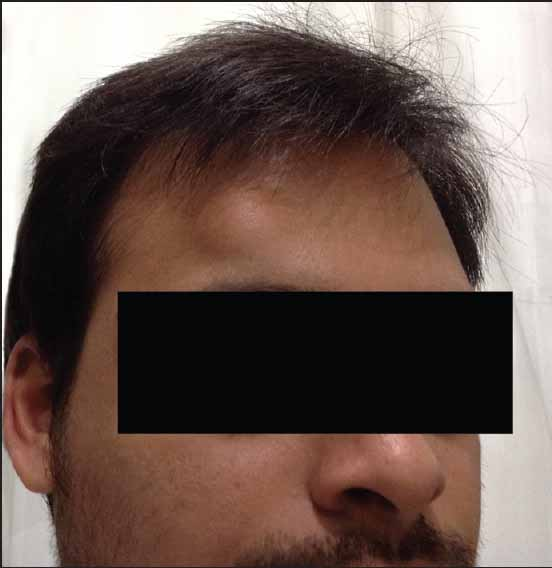Translate this page into:
An Unusual Case of Lipoma Attached to the Frontalis Muscle
This is an open-access article distributed under the terms of the Creative Commons Attribution-Noncommercial-Share Alike 3.0 Unported, which permits unrestricted use, distribution, and reproduction in any medium, provided the original work is properly cited.
This article was originally published by Medknow Publications & Media Pvt Ltd and was migrated to Scientific Scholar after the change of Publisher.
Dear Editor,
Lipomas are the most common benign mesenchymal tumours composed of adipose tissue, which account for almost 50% of all the soft-tissue tumours. Lipomas can occur at any age and can arise in any location, but are more frequently located on the trunk, chest, arm, shoulder and thigh. Lipomas are most frequently encountered in the subcutaneous tissues but very rarely they may be intermuscular or intramuscular, i.e., found within the muscle. We report an unusual case of frontalis-associated lipoma in a 25-year-old male patient because of its rarity.
A 25-year male presented with a single asymptomatic swelling on the right side of the forehead since three years. Clinical examination showed a 2 × 3 cm firm, non-tender, slightly mobile subcutaneous nodule on the right side of the forehead [Figure 1]. Clinically, these features suggested a differential diagnosis of liposarcoma, lipoma, epidermoid cyst, sebaceous cyst or osteoma. All the routine investigations were normal.

- A 25-year-old male with a swelling on the right side of the forehead
We operated under local anaesthesia and made an incision through the skin and subcutaneous fat. However, the plane of swelling was noted to be intramuscular after incision and we reached out to the nodule through the frontalis muscle to reveal a well-circumscribed yellowish mass which was excised and sent for histopathological examination.
Histopathology showed a circumscribed lesion covered by a thin fibrous capsule, composed of mature adipocytes in lobules which confirmed it to be a lipoma. No evidence of malignancy was noted [Figure 2]. The patient was followed up for 6 months and there has been no recurrence [Figure 3].

- H&E 40× showing benign adipocytes with fibrovascular septae

- Post surgical scar on the forehead
Lipomas are often seen in the subcutaneous plane whereas the intramuscular lipomas arise in a deeper plane. Intramuscular lipomas were first described in 1946 and they account for a very small number amongst the fatty tumours.[1]
Fletcher et al. reported that intramuscular lipomas account for about 1.8% of fatty tumours and predominantly occur in middle to late adult life.[2] Histologically, intramuscular lipoma can be either circumscribed, which shows the presence of a fibrous capsule, or infiltrative, which are associated with muscle atrophy and degenerative changes.[2] In 1943, Uriburu first reported the occurrence of lipoma in areas other than subcutis.[3] In 1989, Salasche coined the term ‘frontalis-associated lipoma’.[4] Frontalis-associated lipoma may arise in one of the following locations which could be within the frontalis muscle itself, between the frontalis muscle and the deep fascia, in the loose areolar tissue between the deep fascia of the frontalis muscle and the periosteum called as ‘subgaleal lipomas’[5] and beneath the periosteum.[4]
To ensure proper care to the patient, it is very important to have the knowledge of different subcutaneous nodules of the forehead like liposarcoma, epidermoid cyst, sebaceous cyst, tumours such as osteoma, desmoids, and other fibrous tumour along with frontalis-associated lipoma in a subcutaneous forehead swelling which can have a similar appearance.[5]
As intramuscular lipomas have a significant tendency to recur and can be confused with other forehead swellings, it is important to recognise and distinguish them for a successful surgical excision.
REFERENCES
- Infiltrating benign lipomas of the extremities. West J Surg Obstet Gynecol. 1946;54:87-93.
- [Google Scholar]
- Intramuscular and intermuscular lipoma: Neglected diagnoses. Histopathology. 1988;12:275-87.
- [Google Scholar]





